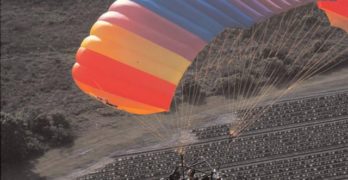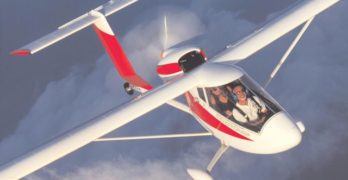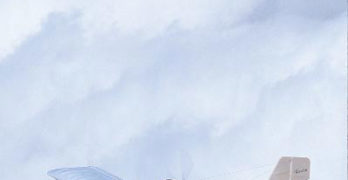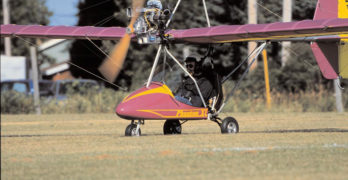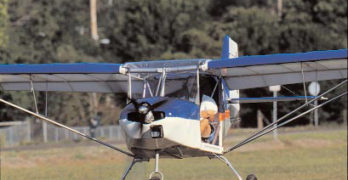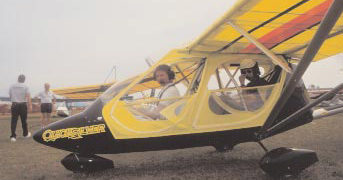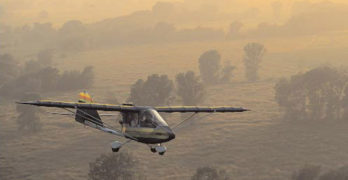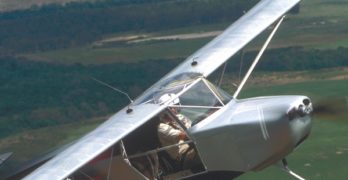A New Powered Parachute From a Well-Known Leader
Randy Snead branches out into his own company
Once an important figure in
Buckeye Industries, Randy is
known to many as the man
who worked on the technical
side and performed flight-testing for
Buckeye. When the former company fell
into struggle (see Editor’s Note), Randy
departed to do his own thing. Customers
who followed state, “It’s the people
behind the company” that are important.
I can find no argument with this
approach; we all tend to trust those we
know.
In turn, Randy is assisted by people he
trusts. His wife, Fern, is the business
manager and also operates the parts and
ordering department for the young firm.
Their son, Jeremiah, has experience in
general aviation aircraft, weight-shift
trikes, and powered parachutes, and he’s
built many powered parachutes. In the
EAA way, Gemini Powered Parachutes is
a family affair.
Introducing Gemini
Powered Parachutes
“It’s the American way” say others.
Search Results for : Flight Design
Not finding exactly what you expected? Try our advanced search option.
Select a manufacturer to go straight to all our content about that manufacturer.
Select an aircraft model to go straight to all our content about that model.
The Vista A-20 Cruiser & Varlet
Eastern European designers deliver nimble machines
UPDATE–November 2008: According to FPNA, an American company with a business relationship to A-20 producer Aeroprakt, the A-20 has been discontinued. Please contact FPNA for more information (contact info at end of article).
As the new millennium got underway,
visitors to EAA
AirVenture Oshkosh 2000 examined
a new aircraft from a
Ukrainian company called Aeroprakt
Ltd. Named the A-22 Valor, the unique
side-by-side two-seat aircraft had a distinctive
cabin largely covered in clear
plastic. It was displayed by John Hunter
and his company, Spectrum Aircraft.
The Valor has turned out to be only
the first in a fleet of light aircraft that
have materialized before American eyes.
In 2001, another Aeroprakt model appeared
on Spectrum’s display space-the
A-20 Vista Cruiser, one of a series of A-20
models.
John Hunter became well
known in the light plane
world while working
for Phil Lockwood,
designer of the much-admired Air Cam.
Rans S-12S Super Airaile
A brave new world of “sport pilot” approaches. Like all things new, it has plenty of allure and some uncertainty attached to it. Its promise is great, but no one, including FAA, can predict how it will turn out. In such times familiar and reliable aircraft become as comfortable as a well-worn helmet. Such standard bearers may not seem as exciting as a new machine, but you can count on them to behave with good manners. In aviation, no proof is better than years of field experience in the hands of many owners.
Into this hazy future flies one aircraft
that qualifies as a known
quantity. The RANS Inc. Airaile
S-12 and S-14 models have established
themselves as some of
ultralight aviation’s most popular aircraft.
RANS reports close to 1,000
Airailes sold (800-plus S-12s, more
than 100 S-14s, and about a dozen S-
12S models). This blows away every
RANS model line except the ubiquitous
S-6 Coyote series; however, even
the S-6 counts only a couple hundred
more deliveries.
Phamous Phantom
Phantom ultralights continue to charm many pilots
The proposed sport pilot and light-sport aircraft rule changes have been
the focus of much discussion and anticipation over the last several
months, and good reasons for such unbridled attention are plentiful.
Under the proposed rule, you can obtain
an FAA sport pilot certificate in as
little as 20 hours and then carry a passenger
without having to become a flight
instructor. Many interesting aircraft will
become available for purchase either as
kits or ready-to-fly light-sport aircraft
(LSA), and these machines will be more “capable” in that they will be faster, better
equipped, more comfortable, and
more closely resemble conventional aircraft.
In many ways, they will outperform
the general aviation aircraft they may
come to replace.
Experts expect financing and insurance
to become more readily available.
And access to America’s 12,000 airports
should follow. You’ll be able to buy fully
built LSA that will qualify for commercial
operations like flight training or rental.
American Trikes – Sidebar 1
Contacts!
Here’s a directory of contact information for
the various companies mentioned in this
article.
• Airsports USA (New York):
phone 718/777-7000
e-mail fly4fun@flyforfun.net
• Antares Ltd. (Alaska):
phone 907/688-7001
e-mail asainc@customcpu.com
• Butterfly Wings by GibboGear (Florida):
phone 863/679-6383
e-mail gibbogear1@aol.com
• Concept Aviation (Tennessee):
phone 865/693-1284.
e-mail aaldon@aol.com
• J&J Ultralights (Florida):
phone 386/330-2007
e-mail jjultralight@aol.com
• Kemmeries Aviation (Arizona):
phone 623/566-8026
e-mail fly@kemmeriesaviation.com
• Lookout Mountain Flight Park (Georgia):
phone 706/398-3541
e-mail fly@hanglide.com
• North Wing Design (Washington):
phone 509/886-4605
e-mail trikes@northwing.com
• Personal Flight (Washington):
phone 509/682-6262
e-mail fly@personalflight.com
• Sabre Aircraft (Arizona):
phone 623/393-0234
e-mail sales@sabretrikes.com
• Skyboat/Paratrike (Texas):
phone 281/852-2228
e-mail ultmark2@phoenix.net
• Soaring Eagle (Texas):
contact was unsuccessful at press time
• TC’s Trikes (Tennessee):
phone 423/802-1193
e-mail tctrikes@mindspring.com
• Top Dog Ultralights (Colorado):
phone 970/749-4838
e-mail topdog@fone.net
• WeTTrike Inc. (Mississippi):
phone 601/947-9281
e-mail sales@wettrikeinc.com
Published in Experimenter Magazine
American Trikes – Sidebar 2
Made-in-USA Trikes
Quick Reference Table
Brand
Models
Airsports USA
DFS Trike, Aerotome
Antares Ltd
Antares 503/582
Butterfly Wings
BB Trike 340/447/503
Concept Aviation
Prowler
J&J Ultralights
Model C, SeaWing, Tukan
Kemmeries Aviation
Trike Zilla, Tukan
Lookout Mountain
SkyCycle
North Wing Design
Apache, Maverick, ATF
Personal Flight
Sky-Tender
Sabre Aircraft
Elite
Skyboat/Paratrikes
Amphib
Soaring Eagle, Inc.
Incredible Flying Boat
TC’s Trikes
TC Trike
Top Dog Ultralights
Top Dog
WeTTrike
WeTTrike
Published in Experimenter Magazine
Sky Ranger
The Leading Trainer in French Flight Schools
To many observers, the Sky Ranger looks like a RANS Coyote. Based on general appearances, it appears the French light plane borrowed heavily from the popular model sold by the Kansas light plane kit leader. But, Sky Ranger importer Richard Helm bristles a bit when he hears that statement and retorts, “People compare the Sky Ranger to the RANS Coyote. They say it’s a knockoff, but the French designer didn’t take anything from the Coyote. It’s built completely different,” although he admits, “It does look a lot like the Coyote.”
Give a Yankee welcome to the Sky
Ranger. The French-designed
ultralight is typical of a trend I
think we’ll be seeing with increasing
frequency—imported light planes from
Europe. Sky Ranger is built in the
Ukraine by Aeros, Ltd. I visited this
factory with Phil Lockwood of
Lockwood Aviation in the spring of
2001. Once built by Synairgy in France,
Sky Ranger production moved to this
former eastern-block country in 1997.
Honoring Mike Sacrey
Note to readers — This article first appeared in EAA Sport Pilot magazine. The layout is unusual because of magazine formatting, but all the text and photo information is as it originally appears… —DJ
AND LEARNING THE HISTORY OF FAR PART 103
Not long after takeoff, the airline captain’s deep voice transmitted the following: “Ah… Los Angeles Center, I see hang gliders not far off my wing. They aren’t in our airspace, but I’m surprised to see these guys up here.”
Thus began the impetus to create
Federal Aviation Regulation (FAR) Part
103. Of course, the rule had no name
at the outset, but one FAA official saw
the future.
Honoring the foresight of this
man, EAA recently inducted W.
Michael “Mike” Sacrey into the EAA
Ultralight Hall of Fame during
ceremonies on November 2, 2001, at
EAA headquarters in Oshkosh,
Wisconsin.
Mike holds an airline transport pilot
(ATP) rating with numerous sign-offs
for a variety of jets and multiengine
seaplanes.
Hawks and their History
A look at CGS Aviation and its Roots
The Hawk and Chuck. Chuck
and the CGS Hawk. They are
absolutely intertwined. While
Chuck has a wife, Pixie (aka Nancy),
and family—four sons (Chuck Jr.,
David, Ted, and Don)—he has
another family in his aircraft.
Going Way Back
Our story this month takes us back
in time. EAA recently celebrated the
induction of Michael Sacrey into the
Ultralight Hall of Fame. He was
present near the beginning of the
movement. But even before
ultralights were officially recognized
as a segment of aviation, Chuck was
doing essentially what he is doing
today—selling flying machines.
In the early days, Chuck built
hang gliders, with names like the
Swooper, Spitfire, and Falcon (models
I through VII). While hang gliding
was most popular on the West Coast
and many major hang glider
manufacturers were located there,
hang gliding was also popular along
the dunes of the Great Lakes, and
Chuck’s operation was one of the
biggest in the eastern part of the
country.
An Escapade Just for You
Engineering design is usually an evolutionary process. While occasionally a breakthrough idea comes to market, most development in aviation is a result of small steps. The Escapade is a good example.
Once Flying K Enterprises (now Sky Raider LLC) offered their Sky Raider. The single-seater had much in common with the immensely popular SkyStar Aircraft Kitfox. In fact, when SkyStar offered their Kitfox Lite single-seater, Flying K built the welded fuselage for them.
Then came the Sky Raider II with a tight back seat that could be used for an occasional ride though not instruction as no controls were installed in the rear. The new Summit offered by Just Aircraft late last year was a variation on the Sky Raider II theme.
Company leadership changes as do their designs and the path from Flying K to Just Aircraft is convoluted; other business names are involved. By example, Rocky Mountain Wings, run by former Flying K partner Stace Schrader, offers their very similar Ridge Runner.
- « Previous Page
- 1
- …
- 136
- 137
- 138
- 139
- 140
- …
- 147
- Next Page »


